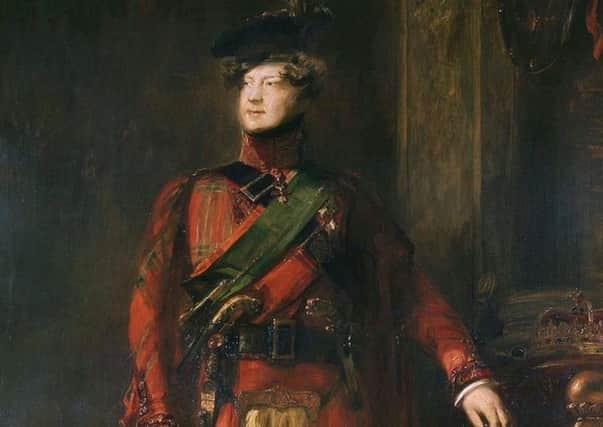OTD 1822: George IV's '˜tartan and pink tights' trip begins


The enduring image of the Royal visit to Scotland, the first since 1633, was the portly King dressed in a Royal Stuart kilt so short he wore pink tights to cover his legs.
Despite the faux pas, the King’s stay in the capital created a rush of popularity for all things Scottish with the kilt becoming the new, acceptable national dress less than 80 years after its everyday wear was banned by the authorities following Culloden.
Advertisement
Hide AdThe visit was stage managed by author Sir Walter Scott, with the writer’s romantic interpretation of Highland life already repositioning Scotland in the public consciousness.
It was Scott’s poem The Lady Of The Lake, set around Loch Lomond and the Trossachs and published in 1810, that has been credited with single-handedly creating the Scottish tourist industry.
Now, the King’s attire in Edinburgh and Scott’s instructions that gentlemen attending a Highland Ball in honour of the royal visit should dress in ‘the ancient Highland costume’, added a heavy dose of tartan to this new image.
Accounts of the day detail how George IV arrived at Leith on August 15 to cheering crowds who stood on scaffolding placed around the Customs and Excise building to allow spectators a view of the King.
He proceeded in a travelling carriage, surrounding by yeomanry and various gatherings of clansmen, up Leith Walk, which was considered the most impressive route for the King to take.
“No city in Europe can boast a nobler avenue. It gives the idea of grandeur and massiveness, perhaps, more than even the approach by the Waterloo Bridge,” one publication printed ahead of the visit said.
Advertisement
Hide AdAfter arriving at Picardy Place, the door of the carriage was opened by the Lord Provost and magistrates , who presented the King with the keys to the city, a sword and mace, on a crimson velvet cushion.
The procession then continued up York Place, North Street, St Andrew Street, Princes Street and then onto Holyrood House.
Advertisement
Hide AdThe King preferred to stay in Dalkeith Palace during his time in Edinburgh, given the run down state of Holyrood.
Reporters of the day were invited into the home of the Duke of Buccleuch to see preparations take place. While not impressed with the poor state of the gold lace on the throne put in place for the King, they were more taken by the King’s bed and the scarlet leather chair by its side.
The schedule for the trip included a run of processions, pageants, parties, receptions and church services, with the King staying in Edinburgh until August 29.
John Murray, the 4th Duke of Atholl, later described the visit as ‘one and twenty daft days’ and noted in his journal that: “The Mania is the Highland garb . . . a considerable Procession of Troops, Highlanders and the different Persons dressed up by [Sir] W: Scott in fantastic attire.”
